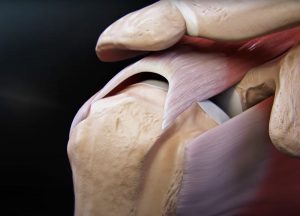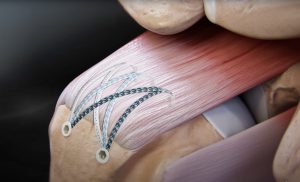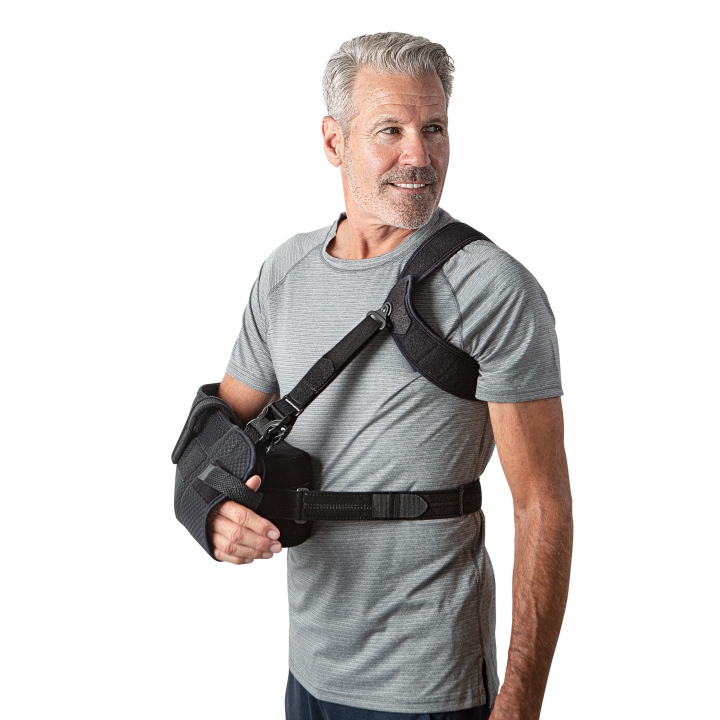Anatomy
The rotator cuff is comprised of the 4 muscles and tendons that surround the top of the upper arm bone (humerus) and hold it in the shoulder joint.
A tear may result suddenly from a single traumatic event or develop gradually. There is often a preceding history of some pain over the outside of the shoulder/arm particularly when doing activities such as putting on a jacket.
Rotator cuff tears may be partial or full-thickness. Full-thickness tears may require surgery if they continue to cause problems (pain or weakness) despite conservative treatment. Surgery may also be used to treat partial-thickness tears that do not respond to nonoperative treatment.
How is the diagnosis made?
The history of the symptoms will be taken and the shoulder examined. There are usually certain positions in which the shoulder feels more painful.
Investigations can include
X-Ray
Ultrasound
MRI
Treatment options
In most cases, the initial treatment is nonsurgical and involves several modalities.
- Rest. If the tear is due in part to overuse, resting the shoulder may help.
- Physiotherapy to strengthen the muscles, especially those which are not torn.
- Nonsteroidal anti-inflammatory medications will help control pain.
- Corticosteroid injections can help reduce pain.
- Suprascapular nerve blocks can be appropriate for some patients
There are several surgical options to treat rotator cuff tears, depending on the size and how long the tendons have been torn . If other problems with the shoulder are discovered during the surgery, they can be corrected at the same time.
Rotator cuff repair
It takes some time to recover from shoulder surgery. A sling needs to be worn for up to a month after surgery and full function may not return for up to a year. A physiotherapy program of exercises to strengthen and restore motion will be started after surgery. Commitment to following the program will make a difference in the ultimate results. Although every case is unique, surgery can relieve pain for most people and rehabilitation can restore a functional (but often not full) range of motion.
Anaesthetic
General Anaesthetic with an interscalene block (Fully asleep with a local anaesthetic injection into the side of the neck will numb the nerves to the shoulder for post-operative pain relief)
Operation type
Arthroscopic (keyhole)
Incisions
3-4 ½ cm incisions will be made in the shoulder, one to the back and two at the front of the shoulder.
Procedure
The gleno-humeral (shoulder) joint will be inspected first.followed by the subacromial bursa and the rotator cuff.
A soft tissue shaving device will be used to clear any scar tissue away.
The edges of the cuff tear are tidied with the soft tissue shaver and sutures passed through the tendon and attached to the bone.

Rotator Cuff Tear 
Rotator Cuff Repair
Animation of Rotator Cuff Repair
Wound Closure
Small butterfly paper stitches will be used to close the wounds.
Tegaderm waterproof dressings will be placed over the top of the paper stitches.
Pain relief
The anaesthetist will discuss a nerve block which will be administered after you are asleep, this means that you will wake up with no pain in the shoulder but the arm will feel numb for up to 12 hours. You will be prescribed painkillers to start taking when you get home and we encourage you to take these regularly for at least the first few days. There will be some discomfort but this settles quite rapidly and ice packs can be used in addition if you wish.
Wound care
The dressings will be changed before you go home and these can be left alone until they are removed. Typically they can be removed 10 days after surgery just by peeling them off and you do not need to visit the doctor for this.
The dressings are showerproof and you will be given some spares in case they start to peel off.
Rehabilitation after surgery
You will wake up with a sling on your arm. It is ESSENTIAL that you wear this as instructed

Instructions on how to fit the Ultrasling PRO
There are two different rehabilitation protocols depending on the size of the tendon tear -you will be told which protocol to follow after surgery and it will be written on the operation note
Physiotherapy instructions small rotator cuff tear
Physiotherapy instructions medium / large rotator cuff tear
Surgical Risks
Every operation has a degree of risk. It is important that you are aware of these risks before you agree to proceed with your operation.
If you decide not to proceed with surgery there is a possibility that the symptoms will settle on their own but they may continue and they may get worse. You will not damage the shoulder if you decide not to proceed with surgery.
The most common or significant risks are outlined below. A risk of 0.1% means that 1 in 1000 people will suffer the complication
- Failure of the procedure to relieve symptoms: 5%
- Superficial Infection (requiring antibiotics): 0.16%
- Deep Infection (requiring further surgery): 0.02%
- PE (Pulmonary Embolus) (Blood clot in the lung): 0.13% – Blood thinning medication is required for several months. Can rarely result in death.
- DVT (Deep Vein Thrombosis) (Blood clot in the leg): 0.14% – Blood thinning medication is required for several months. Can lead to PE
- Nerve Injury: 0.01% – Usually temporary. Can cause weakness around the shoulder with loss of function and rarely can be permanent.
- Heart attack: 0.02%
- To put these numbers in perspective
The chance of:- Getting three balls in the UK national lottery: 0.9%
- Needing emergency treatment in the next year after being injured by a can, bottle, or jar: 0.1%
- Death by an accident at home: 0.01%
- For a 50 year old man in good health the 5 year risk of dying is 0.8%
Frequently asked questions
Return to work after surgery
This is very much dependent on the type of work that you do, whether you need to drive to get to work and the type of surgery that you have had done.
You, as the patient, have the best idea of the specific demands that are required of you to do your work safely and effectively.
Having an operation with an anaesthetic often takes more out of people than they would expect. Generally it is probably worth taking at least a week off from your regular work after having had any procedure.
You should discuss expected post-operative recovery and work with the surgeon before your operation.
Driving after surgery
To be able to drive safely you should be capable of actively moving your shoulder without assistance and without damaging the surgical repair. You should be able to react normally to avoid causing injury to yourself or others due to a lack of control.
Typically this is a MINIMUM eight weeks after a rotator cuff repair.